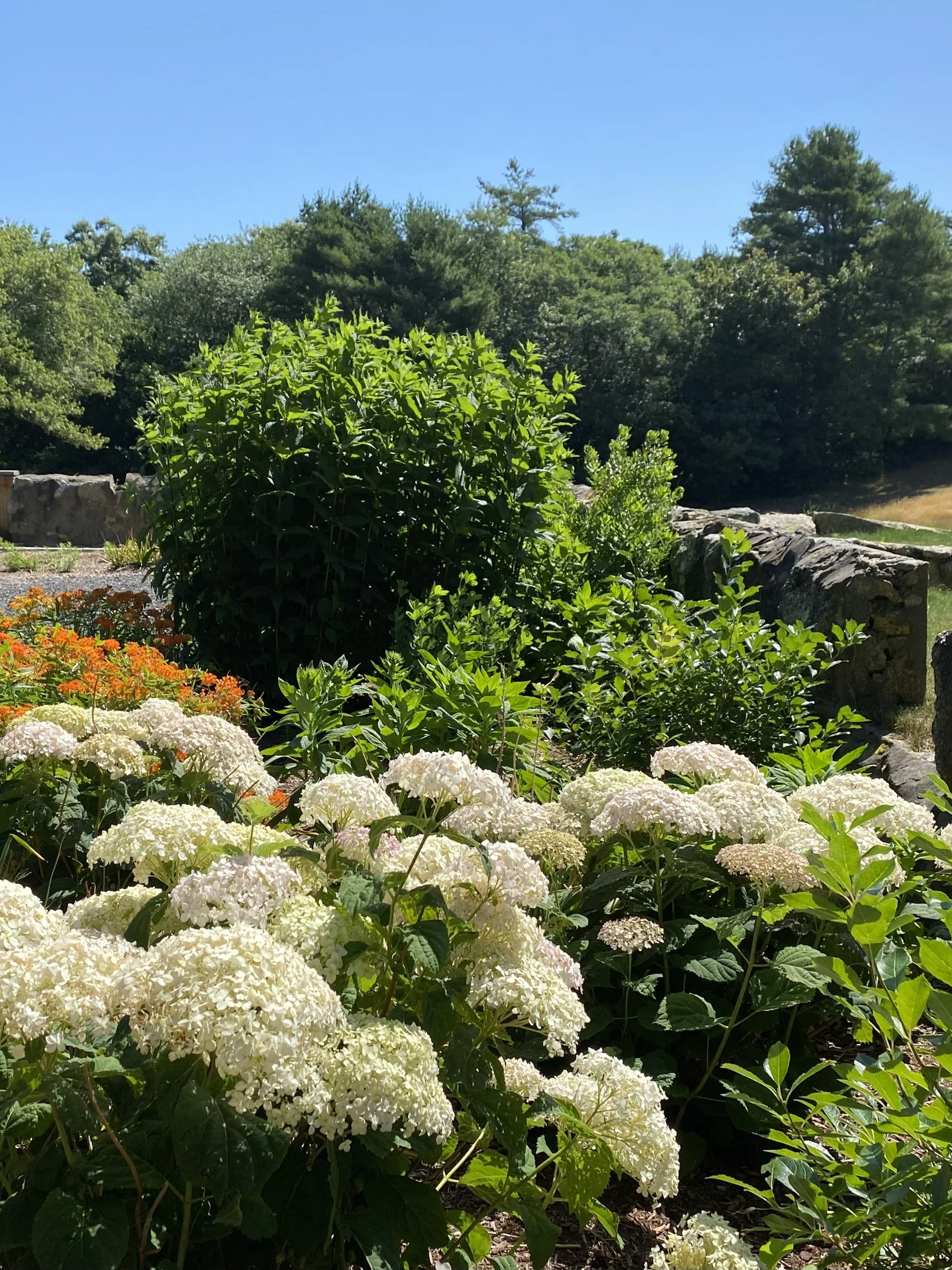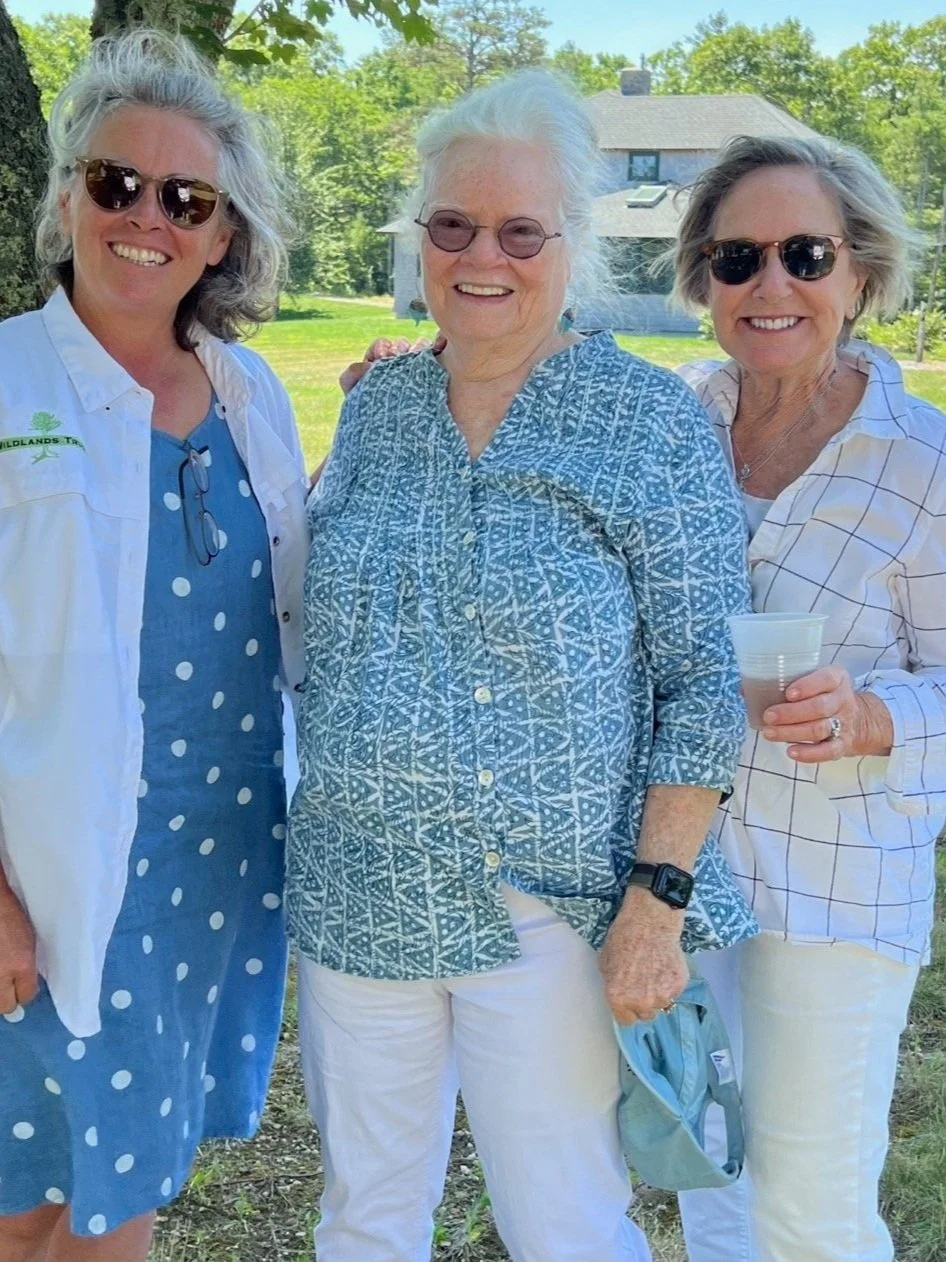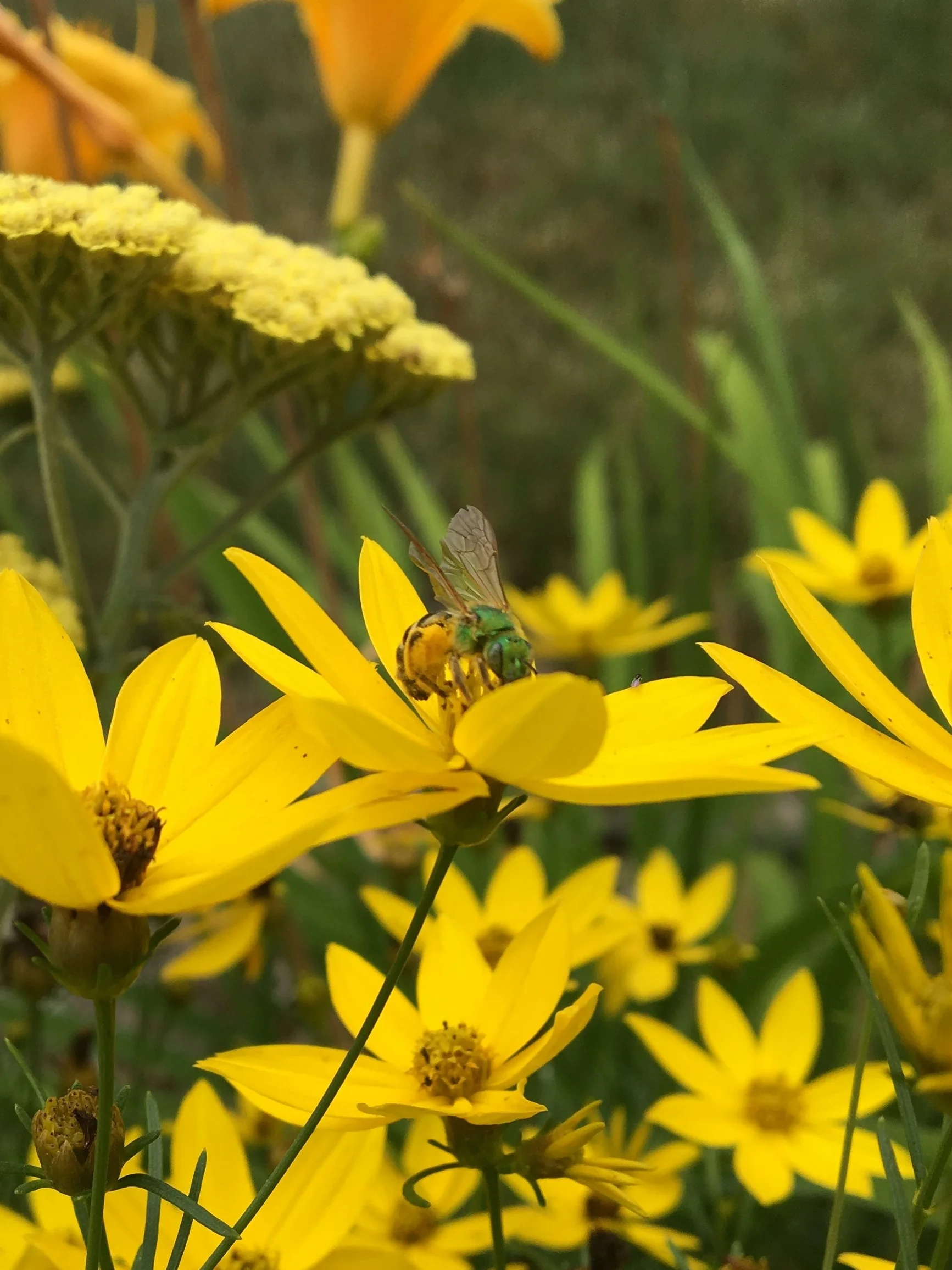What’s New at Wildlands
Welcome Pollinators to Your Garden This Spring
A bee rests on a dahlia in the Community Garden at Davis-Douglas Farm.
By Marilynn Atterbury, Key Volunteer
With the first day of spring right around the corner, green thumbs across Southeastern Massachusetts are twiddling with excitement. Gardeners are already dreaming of the flowers and produce that will revitalize their eyes, noses, and tongues after a long, dark winter.
But in early spring, protect the pollinators that sustain your garden and local ecosystem by leaving busyness to the bees. Believe it or not, the best thing you can do for your pollinator garden right now is nothing at all!
Many pollinators, especially bees and butterflies, spend the winter nestled in garden debris. If you rake up those pesky leaves too soon, you will literally be throwing away this year’s pollinators. Wait until the weather warms to a consistent 50 degrees—usually in late March or early April—for your garden clean-up.
Another early-spring tip: bees wake up hungry! So, make sure to plant early-blooming flowers, such as bleeding heart, lungwort, or ajuga. Even a little sugar water will help.
And don’t forget a water source: a shallow dish with flat rocks (for butterfly perching habitat) will do nicely.
Follow these simple tips this spring, and soon your gardens will be alive with pollinators!
Marilynn (center) helps two high school students restore the Community Garden during Summer of Service.
Marilynn is a primary gardener at Davis-Douglas Farm, and the founder of our pollinator garden. She is also a Wildlands board member, Adopt-a-Preserve lead volunteer, event decorator, and more! Say hello the next time you visit our Plymouth headquarters.
Native Plant Garden in Plymouth Dedicated to Deborah Wood Davis
Read Time: 3 min
By Amy Markarian, Senior Copywriter
On Saturday, July 9, at 10:30am, before the morning sun invited summer’s characteristic heat and humidity, approximately 70 community members gathered at Wildlands Trust’s headquarters on Long Pond Road to dedicate the property’s native plant garden to a longtime supporter of the Trust’s mission, Deborah Wood Davis.
Deborah Wood Davis married into the family of Howland Davis, the previous owner of the land that is now Wildlands’ Davis-Douglas Conservation Area. Her family recalls Deborah’s great affection for the area and, according to her daughter Caroline Chapin, she was excited by Wildlands’ mission and the way it drew the community together. So, when Deborah’s five daughters were looking for a way to honor their mother and the strong roots and connections she had established here, they came to Wildlands Trust.
Sarah Geer, one of those daughters, approached Wildlands’ President and Executive Director Karen Grey to discuss the idea at just the right time. Wildlands had been struggling with the desire to maintain some component of the property’s historic barn, but its crumbling foundation walls and the steep drop from ground level to its interior depth posed hazards that had to be addressed. Simultaneously, local landscape architect Love Howard had also reached out to Karen with the idea of designing a pollinator-friendly garden using native plant species that would support the local ecosystem, and she was looking for a location where she could bring the idea to life. The Davis family’s gift to honor their mother provided the needed support to begin the process of converting the unsafe barn foundation into a showcase garden and educational tool at Wildlands’ headquarters.
The project, according to Karen, “brought together need with opportunity and allowed us to make meaningful connections for people, which are always the best type of projects.” In the fall of 2020, after structural work was completed, the first plants were added by a group of volunteers—including some of Deborah’s daughters, Wildlands volunteer and Board Member Marilynn Atterbury, and others—under Love’s guidance. Today, Marilynn continues the work, along with Wildlands’ gardener Kim Goggin, carefully maintaining and enhancing what is often called “the foundation garden.”
On the morning of the dedication ceremony, the gardening team’s hard work and meticulous care were on full display for the large crowd that had assembled for the occasion. In what would have been Deborah Davis’ 100th year, according to Caroline, the family organized a mini reunion around the dedication ceremony, bringing all five daughters, spouses, children, and almost all of the grandchildren and great-grandchildren together in Plymouth—a gathering of community that would likely have brought the family’s matriarch great pleasure. Also in attendance were several of Wildlands’ staff members, Board members, and supporters. Karen Grey addressed the group with gratitude for all who contributed to the project, Sarah Geer shared reflections of her mother, and Love Howard described her inspiration and plan for the garden’s creation. As the ceremony concluded, with a comfortable breeze under bright blue sky, the flitting of bees and butterflies entertained visitors as they reminisced and explored the newly dedicated Deborah Wood Davis Native Plant Garden.
New Garden in the Old Foundation
By Outreach and Education Manager Rachel Calderara
If you have ever visited Wildlands’ headquarters at Davis-Douglas Farm (DDF) in Plymouth, you have likely wondered about the old granite foundation in the middle of the field. These blocks of granite are what remains of the 1890s barn that stood for about 100 years before collapsing. Since Wildlands acquired Davis-Douglas Farm in 2011, we have made a number of transformations to turn this land into our new headquarters, including restoring the old farm house to make a unique office building and erecting the Community Conservation Barn for community gatherings, which is complete with a three bay garage and woodshop for our stewardship needs. The foundation remained a relic of interest for staff and visitors alike, a beautiful granite structure in the middle of our headquarters that was unused and unsafe to enter.
For years we brainstormed ways to use this foundation, which would complete phase four of the Davis-Douglas Farm transformation. Finally, we found the answer when landscape designer Love Albrecht Howard came to us with the idea to build a demonstration garden with plants native to New England. We worked once more with Jerry Richmond, who has been a great partner throughout the DDF transformation. To prepare for its transition to a garden, Jerry and his team filled the foundation, removed a section of granite to create additional handicap parking, and repurposed this granite to build a beautiful staircase entrance from the lower field. The upper entrance was modified so a wheelchair can enter without difficulty and traverse the pathway that leads to a wide semi-circle seating area with granite benches.
On November 2 and 3, volunteers gathered to bring the garden to life under Love’s direction. We want to thank volunteers Caroline Chapin, Sarah Geer, Nina Pollock, Marilynn Atterbury, Charlotte Russel, Margi Delafield, Elaine Lackey, Lois Post, Lucy Hutchinson and Susan Wolfe for their help with planting, and to those who helped water the garden regularly in the following weeks. And of course, we want to thank Love Albrecht Howard, whose vision, hard work, and dedication to wild spaces was the driving force behind this project.
We encourage you to check out this new demonstration garden on your next visit to Davis-Douglas Farm. The garden is designed for there to be new plants of interest in bloom throughout the year. The plants did well establishing their new home this fall and we are looking forward to watching the garden blossom next year!
Pollinator-Friendly Spring Cleanup for your Garden
By Education and Outreach Manager Rachel Calderara
With warmer, longer days here at last, many people are getting ready to do their spring-cleaning — both indoors and out! At Wildlands Trust, it is almost time to clean up our native perennial gardens as new growth emerges from the soil. However, if we hold off on the cleanup for long enough, it gives hibernating insects time to emerge. Outreach and Education Manager Rachel Calderara spoke with Wildlands Trust’s gardener, Kim Goggin, to learn more about the native perennial gardens at Wildlands Trust headquarters, Davis-Douglas Farm, and the pollinator-friendly practices she uses.
Rachel: First, what kinds of native plants for wildlife do we have at Davis-Douglas Farm?
Kim: For bees, we have black-eyed Susan, yarrow and Coreopsis. For monarch butterflies, we have the host plants Asclepias tuberosa (orange butterfly weed) and Asclepias incarnatoa (swamp milkweed). Then we have Chelone glabra for Baltimore checkerspot butterflies and aster for pearl crescent butterflies. For birds, we have winterberry and cranberry viburnum, as well as Monarda (bee balm) for hummingbirds.
R: What insects benefit from these plants over the winter and into early spring, and why are they important?
A view of the front garden at Wildlands’ headquarters at Davis-Douglas Farm.
K: Over the winter, many insects in various forms of life burrow beneath leaves, in the soil, in decaying branches and in spent stalks of native perennials. Among them are solitary bees, syrphid flies, parasitic wasps, morning cloak butterflies and moths such as the wooly bear caterpillar. Luna moths form a chrysalis, which looks much like a curled, dried leaf, and spend the winter there.
Some of our native plants are host plants for specific butterflies to lay their eggs, while others provide nectar for pollinators throughout the season, giving them the energy they need to either migrate or overwinter. Butterflies we frequently see at Davis-Douglas Farm include monarchs, American lady and painted lady butterflies.
R: How can we help protect these insects during our spring garden cleanup?
K: Foregoing fall clean-up all together and postponing spring clean-up until temperatures have stayed consistently above 50 degrees for several days insures that insects will have enough time to emerge from their winter state of diapause. This means leaving spent stalks for the winter, delaying raking leaves and watchfully pruning, as some moths such as the Luna moth may form chrysalises on branches for the winter.
R: After cleanup, is there anything else we can do to help protect native pollinators?
A monarch chrysalis hangs from milkweed at Davis-Douglas Farm.
K: Most importantly, do not use pesticides. You can provide brush piles where insects can feed, bare patches of earth for ground nesting bees (out of the way of any foot traffic) and shallow dishes of water mixed with a bit of soil to provide minerals for butterflies. Plant a variety of heights, colors and flower shapes in your garden. Plant in groupings so pollinators can move easily from one flower to another. Provide flowering plants from early spring into late fall.
R: What plants would you recommend adding to perennial gardens this year to help native wildlife?
K: Zizia is one perennial I would like to add this year, as it is the host for the black swallowtail butterfly. In addition, Heliopsis (false sunflower) proves nectar for native bees and goldfinch love the seeds in the fall.
We want to thank Kim Goggin for all she does to keep our gardens beautiful and pollinator-friendly at Wildlands Trust! Everyone can help pollinators in their own gardens by following her simple advice. Happy spring-cleaning!
From Farmland to Grassland
How Wildlands’ management of former farmlands provides a reliable habitat for pollinators and other wildlife throughout the South Shore.
By Membership & Communications Manager, Roxey Lay
When you think of a Wildlands Trust preserve, you may immediately think of trails that lead visitors throughout woodlands to explore the undeveloped pockets of the region. What you may not think of immediately are fields. In addition to the wooded areas Wildlands protects, there are also a number of former farms, managed by stewardship staff to remain as open grasslands. Habitats like these fields tend to disappear in this part of the state, either through development, the installation of solar fields, or through lack of management. “Grasslands don’t want to stay grasslands”, Stewardship Manager, Erik Boyer explains. “Their natural state is forest.” With fewer grassland habitats throughout the region, Wildlands makes it a point to maintain a number of properties like Great River Preserve, Willow Brook Farm Preserve, and Phillips Farm Preserve, as such in order to provide a stable habitat and foraging area for wildlife that rely on vegetation that grows there.
Joe-pye weed, Eutrochium purpureum, grows at Great River Preserve in Bridgewater.
A primary group that rely on these areas are pollinators, like bees. Throughout North America, there are nearly 4,000 native species of bees [1]; however, 14 species in New England are on the decline by as much as 90% [2]. This does not include the European honey bee, which is not native to North America, having been brought over in the 1600s by the colonists. In an attempt to pinpoint the cause of this decline, “scientists have blamed a range of factors including insecticides (neonicotinoids), parasites, disease, climate change and lack of a diverse food supply” [2]. Native flower diversity is a critical part in helping the region’s native bee species as well as having various plants that bloom during different months throughout the year. “Having large open fields that have native plants that provide a continuous food supply to common and specialty bees are important”, explains Plymouth County Entomologist, Blake Dinius. “Many types of bees only forage during certain months out of the year.” A large number of common plants that attract generalist foragers like honey bees and bumble bees aren’t always adequate for specialist species who only feed on specific flowers; if those types of plants aren’t available, these species die off.
The distance between foraging sites is important as well. “Bees and other insect pollinators require nesting sites (suitable soil, dead wood, abandoned mouse nests, burrows) and floral resources (nectar and pollen) to persist” [3]. Unlike the honey bee, which lives in a hive, 70% of all bees nest underground [4] and viable nesting and foraging sites like open grasslands are at risk due to “row-crop agriculture, grazing and fragmentation of habitat” [3]. While larger species like honey bees and bumble bees travel 2-3 miles (sometimes farther) outside of their nesting location for food, many solitary bees, who are smaller yet “known to pollinate plants more efficiently than honey bees” [5], travel very short distances (typically less than a mile). Maintaining sites that are relatively close together are important in supporting the wide range of needs among various species.
Habitat loss and fragmentation, the process of reducing large tracts of land into smaller pieces via development, “are currently the main threats to terrestrial biodiversity”[6]. Wildlands works to expand continuous areas of ecological significance when acquiring land by identifying parcels that share borders with properties protected by towns and other organizations. This type of collaboration results in the creation of larger wildlife corridors throughout various habitats. Willow Brook Farm in Pembroke is a prime example of this. The roughly 167 acres that compose Willow Brook are nestled between Herring Run Historical Park and Misty Meadows Conservation Area. The shared borders between these three conservation lands results in a much larger protected area and reduces the distance between open spaces.
In short, Wildlands’ preserves which contain managed open fields provide food, a safe place to nest and a pesticide free environment for pollinators and other wildlife who rely on them. While there is much to learn in regards to why bees are facing declining numbers, there’s no doubt these spaces play an important role in their survival and the overall environmental health of the region. Through the preservation of varied habitats that include these grasslands, Wildlands and other land conservation organizations are working together to secure expansive tracts of vital habitat that may otherwise be lost forever.
A map showing the shared borders of Misty Meadow Conservation Area, Willow Brook Farm Preserve and Herring Run Historical Park.
[1] https://www.popsci.com/science/article/2013-06/10-spectacular-native-bees/
[2] https://www.apnews.com/f768748b36c648e49c14b0366fdec7e8
[3] https://www.nap.edu/read/11761/chapter/5#93
[4] https://entomology.cals.cornell.edu/extension/wild-pollinators/native-bees-your-backyard/
[5] https://www.growwilduk.com/wildflowers/bees-pollinators/take-crash-course-solitary-bees
[6] https://www.sciencedirect.com/topics/earth-and-planetary-sciences/habitat-fragmentation


























